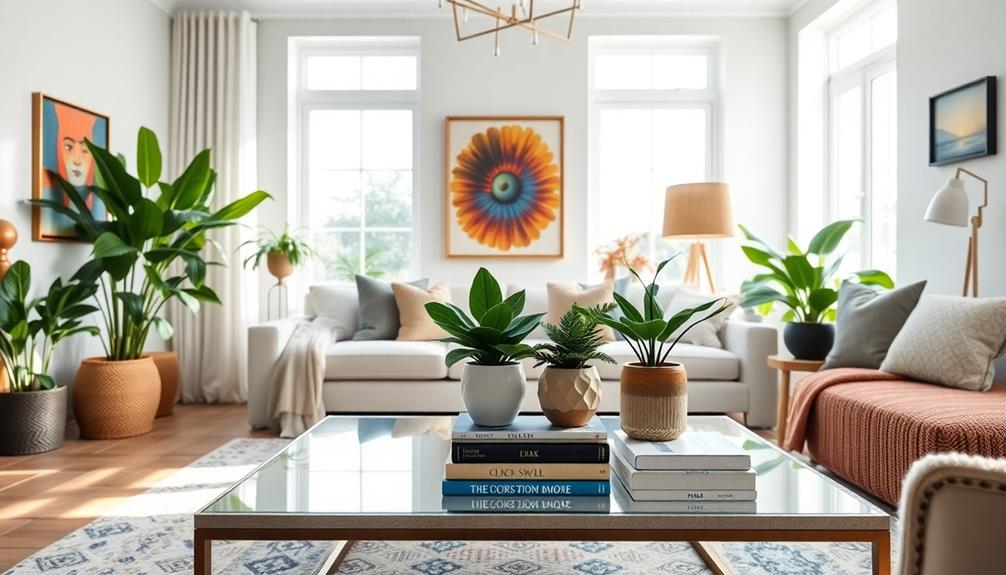To enhance your home decor on Instagram today, begin by identifying your unique style – whether it’s bohemian or minimalist. Utilize natural light to capture captivating visuals and try out different angles for engaging shots. Interact with your followers by responding to comments and utilizing Instagram Stories for exclusive behind-the-scenes peeks. Remember to utilize hashtags effectively to expand your audience, and craft intriguing captions that narrate a story. Develop a content calendar to maintain consistency, and explore innovative decor trends to keep your feed up-to-date. Stay tuned for more tips to enhance your Instagram presence even more!
Key Takeaways
- Define a unique style by exploring aesthetics and selecting a cohesive color palette that reflects your personality and creativity.
- Capture stunning visuals using natural light and experimenting with angles, ensuring your photos tell a compelling story.
- Boost follower engagement by interacting promptly and using Instagram Stories, Reels, and polls to create a dynamic community experience.
- Master hashtags and captions by researching trends, crafting captivating narratives, and analyzing performance to enhance reach and engagement.
- Plan content strategically with a calendar, mixing various content types and incorporating seasonal themes to maintain consistency and interest.
Define Your Unique Style

When you start decorating your home, it's essential to identify your unique style so you can create a space that truly reflects who you are.
Begin by exploring different aesthetics, like bohemian, minimalist, or industrial, and see which resonates most with you. Once you have a vision, select a color scheme that complements your decor pieces—whether you prefer bold and vibrant or calm and neutral tones.
Curate unique decor items that showcase your personality and enhance originality. Consistency is key; maintain a cohesive palette to make your space feel harmonious.
Don't hesitate to incorporate DIY projects that express your creativity. By defining your style, you'll not only create a beautiful space but also establish a theme for your Home Decor Instagram that draws in followers.
Capture Stunning Visuals

With your unique style defined, it's time to focus on capturing stunning visuals that showcase your home decor. Start by using natural light to illuminate your space, making colors pop and details shine.
Consider incorporating elements from modern farmhouse decor trends to create a warm and inviting atmosphere. Apply the rule of thirds for balanced compositions, ensuring each shot feels intentional.
Experiment with various angles to add depth and intrigue; sometimes a low shot or a bird's-eye view can make all the difference. Incorporate props to enhance your narrative, whether it's a cozy throw or a vibrant plant.
Don't forget to edit your photos for consistency, maintaining a cohesive color palette and aesthetic. Finally, showcase transformations with before-and-after shots to highlight your design journey and creativity.
Boost Your Follower Engagement

Regularly engaging with your followers can greatly enhance your Instagram presence and foster a loyal community. Start by responding promptly to comments and direct messages; it shows you value their input.
Use Instagram Stories and Reels to share behind-the-scenes content, making your followers feel more connected to your process. Host giveaways or contests to excite your audience and attract new followers.
Create engaging polls and quizzes in your stories to encourage interaction and gather insights. Collaborate with other influencers and brands to broaden your reach and establish credibility.
Master Hashtags and Captions

Engaging your audience goes hand in hand with mastering hashtags and captions. Start by researching trending hashtags like #interiordesign and #homedecor to expand your reach.
Don't forget to include niche hashtags to connect with specific followers who share your interests. Create a branded hashtag to foster community around your unique content and keep it updated based on current trends.
When it comes to captions, be enthralling! Tell a story that resonates with your audience, and always include a call-to-action that encourages engagement. Ask questions or invite followers to share their thoughts.
Regularly analyze your hashtag performance to refine your strategy. By combining effective hashtags and engaging captions, you'll elevate your home decor Instagram and build a loyal following.
Protect Your Creative Work

Protecting your creative work is essential in the competitive world of home decor on Instagram. To keep your content safe, consider these strategies:
| Action | Purpose |
|---|---|
| Watermark your images | Deter unauthorized use |
| Use strong passwords | Secure your account from hackers |
| Educate yourself on copyright laws | Understand your rights as a creator |
| Monitor for infringement | Quickly address content theft |
| Report violations | Maintain the integrity of your work |
Plan Your Content Strategically

After guaranteeing your creative work is safeguarded, it's time to focus on how to effectively plan your content. Start by defining your target audience and understanding their interests.
Create a content calendar to maintain consistency; this helps you stay organized and guarantees regular posting. Set specific goals, like increasing engagement or followers, to measure your progress.
Mix up your content types—photos, videos, and stories—to keep your feed dynamic and engaging. Don't forget to incorporate seasonal themes or trending decor styles to stay relevant.
Explore Innovative Decor Trends

How can you stay ahead in the ever-evolving world of home decor? Embrace innovative trends that blend functionality with style. Incorporate natural materials like bamboo, rattan, and teak to add warmth and authenticity to your living space. Additionally, consider Indonesian home decor tips, such as using intricate batik patterns or hand-carved wooden accents, to introduce a unique, artisanal touch that exudes both elegance and cultural richness. Ultimately, staying ahead means continually exploring global influences while balancing comfort and sustainability.
Consider tech-integrated furniture that enhances your space while offering convenience, as this approach aligns with the effective networking essential for business growth. Multifunctional designs allow you to maximize smaller areas without sacrificing aesthetics. Eco-friendly materials not only elevate your decor but also support sustainability, appealing to conscious consumers.
Keep an eye on bold colors, like deep greens and warm terracottas, that create inviting atmospheres.
Don't shy away from mixing textures, such as wood with metal, to add depth and interest. Finally, explore vintage finds that tell a story, giving your space a unique touch.
Frequently Asked Questions
How Often Should I Post on My Home Decor Instagram Account?
You should aim to post 3 to 5 times a week on your home decor Instagram account. This frequency keeps your content fresh and engaging, helping you maintain visibility and grow your follower base effectively.
What Are the Best Times to Post for Maximum Engagement?
Studies show that posting between 9 AM and 11 AM on weekdays can boost engagement by up to 30%. You should experiment within this window to find your audience's peak activity times for maximum interaction.
Should I Focus More on Videos or Photos for My Content?
You should focus on a mix of both videos and photos. Videos showcase dynamic transformations and engage viewers, while high-quality photos highlight details. Experiment to see what resonates best with your audience and adjust accordingly.
How Can I Find Local Home Decor Influencers to Collaborate With?
You'll stumble upon local home decor influencers at community events, markets, or online platforms. Try searching Instagram hashtags, joining local Facebook groups, or attending workshops—collaborations often spark unexpectedly, so keep your eyes open!
What Tools Are Recommended for Scheduling Instagram Posts Effectively?
To schedule Instagram posts effectively, you can use tools like Later, Buffer, or Hootsuite. They let you plan content in advance, analyze performance, and guarantee consistent posting, saving you time and enhancing engagement.
Conclusion
By embracing these strategies, you're not just showcasing your home decor; you're inviting others into your personal sanctuary. Imagine the joy of connecting with a community that shares your passion, where each post sparks inspiration and creativity. As you transform your feed, remember that every detail of your space tells a story—your story. So go ahead, let your unique style shine and watch as your Instagram evolves into a vibrant tapestry of home decor magic!









